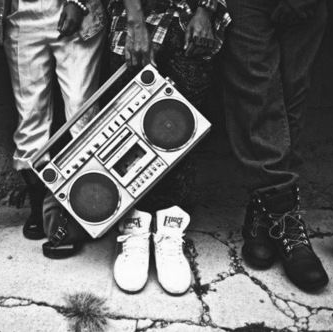
Hip Hop’s exponential impact on pop-culture makes for an intriguing sociological case study. This once niche genre, born out of fighting oppression, has not only developed into a mainstream sound, but has ostensibly supplanted pop music. Its quick, intense scale elevated it from urban pockets to the global stage in just over three-decades. Sure, gentrification could be argued, but this widened, deepened demographic has granted Hip Hop the exposure to mold music like never before.
It progresses yearly through risk and innovation, further inflating its cultural reach and diversifying its aesthetic. For awhile, these advancements were celebrated, as they represented the genre’s increased attraction and acceptance. Of course, friction occurred: the stubborn, stereotypical veteran mentality of “back in my day” has followed Hip Hop since its origin; beef perpetually arises between new talent and old heads, like LL Cool J and Kool Moe Dee, or Drake and Common. But the quarrels never seemed to challenge the genre’s DNA. Rather, they supplemented Hip Hop’s appeal through adding tangent narratives. Now, with the engulfing rise of “mumble rap,” a reductive term, this generation’s old heads are emotionally lobbying for Hip Hop’s restoration, neglecting the subgenre’s association with their dearly beloved.

Fundamentally, I am confused. I understand that change is scary, but why be threatened by it? Why not view it as growth instead of deterioration? Why can’t Hip Hop’s scope expand to include alternative styles in conjunction with its traditional lane? There is room for derivatives and the original formula to coexist. Mumble rap’s allure may be mushrooming, but “real rap” is very much still alive, evidenced by anyone on TDE, anyone on Dreamville, Pusha T, Joey Bada$$, Chance The Rapper, A$AP Rocky, Denzel Curry—the list goes on. Hip Hop purists view the new wave as degrading because it typically de-emphasizes lyricism, but this innovation should be celebrated, as it signifies expansion. Mumbling and voice contortion add a different flavor, bolstering Hip Hop’s musicality by increasing the genre’s thread count. Why is there this urge to classify Hip Hop so formulaically?
Ella Fitzgerald is a celebrated Jazz figure revered for her scat singing. “Scat singing” converts the human voice into an instrument by combining melodies with nonsensical words and syllables to create pleasing sounds that complement traditional Jazz music well. Ella is a Jazz legend. No one ever told her that she was compromising Jazz’s integrity through her senseless verbiage.
Young Thug is a polarizing Hip Hop figure who typically employs indecipherable discourse; he is a modern day scat singer. His horse, contorted voice is an auditory acrobat that bends to hit a wide array of notes that pair well with Hip Hop production, specifically trap. People want to hate because they can’t understand him, but here’s the reality: if it sounds good, then it sounds good. Ella was speaking gibberish, but her beautiful voice was applauded. At least Thugger is technically speaking English. Also, just become someone’s flow is unintelligible, that doesn’t mean that their words aren’t meaningful or thought-provoking. Read Kodak Black’s lyrics and tell me he’s not a contemplative writer. These mumblers are simply following in their Hip Hop forefathers innovative footsteps.

Subgenres have always been a Hip Hop cornerstone. Without these derivatives, Hip Hop wouldn’t enjoy its uniquely textured facades, and would fall victim to stagnation, decline, and eventually, death. Innovation is not only the key to growth, but life. Gangsta’ rap paints brutal tales of gang violence; conscious rap relies more on poetry and lyricism to convey ideas; trap music positively and negatively depicts individual's’ relationship with “the trap,” and has since grown into a production focus. These styles differ from each other, but are deeply connected by one thing: Hip Hop. They coexisted in the ‘90s, and they coexist today. The former had guys like 2Pac, Talib Kweli, and UGK, respectively; the latter has Vince Staples, Kendrick Lamar, and Migos. Subgenres will always be a part of the game; we’re right on track with Hip Hop’s evolutionary trajectory. Now, we’re just adding mumble rap to the mix.
We’re fortunate that Hip Hop has reached this point of popularity. With this ubiquity, barriers to entry aren’t necessarily lowered, but admission standards have become more inclusive—different artists can serve different functions. Hip Hop has flourished to the point where it can save more lives, and reach more people. These subgenres aren’t cannibalizing each other, they’re just making more room for artists to eat. For the purpose of this article, let’s assume that music has a defined existence—people have a limited music consumption capacity. With Hip Hop’s increased representation of that listening capacity, people are consuming other genres less and less. Using an extreme to make my point, instead of fans listening to Country, Rock, or Hip Hop, they’ll listen to trap, mumble rap, or conscious rap. But no matter what, it’ll be Hip Hop. Mumble rap’s introduction should be revered, not resisted.
To say that the new wave is killing Hip Hop is ignorant; historically speaking, it’s enriching it through expansion. Old head’s “bad for the culture” argument gives mumble rap too much credibility by placing it on a pedestal, and devalues traditional lyricists. The majority of today’s marquee artists are conventional spitters—people just intensely focus on what they hate, which delusionally magnifies their resentment. Hip Hop is right where it should be: innovating, deepening, evolving.






